I never knew my neighbors were that close until I could hear everything over there, including their intense bedroom play. Then, it struck me; it goes both ways. I’ve no privacy, and my kids keep learning more annoying swear words from my neighbors.
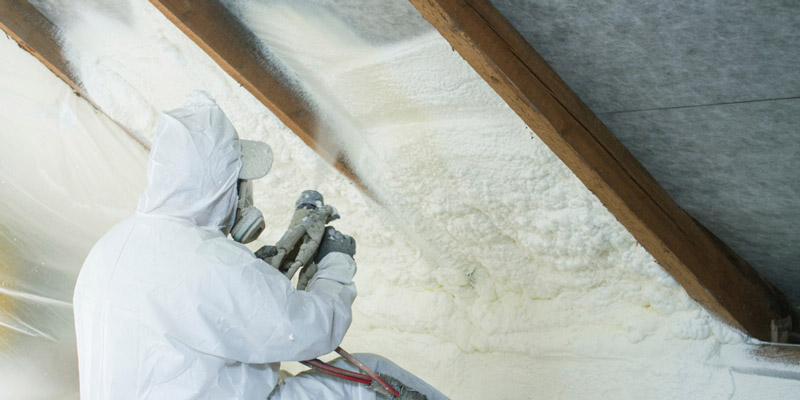
I’ve tried a couple of inexpensive DIY soundproofing tricks online but had only real success once I used spray foam. This is one of the most effective, affordable noise-reduction methods.
It’s cheaper and easy to install. This method does not require you to make any major changes to your existing walls.
But choosing the right one to fill your interior walls is imperative for excellent noise reduction. Luckily, in this post, I’ll share my top 5 best soundproofing spray foam for existing walls.
Soundproofing Spray Foam For Existing Walls
| Rank | Product | Key Features |
|---|---|---|
| 1. | GREAT STUFF PRO Gaps and Cracks | Water Resistant |
| 2. | GREAT STUFF Window & Door Insulating Foam | 2 Pack of 16 Ounce |
| 3. | Loctite Tite Gaps & Cracks White Foam | Long-lasting results |
| 4. | Seal Spray Foam High Performance 80% Plus Foam | Superior Flexibility |
| 5. | GREAT STUFF Window & Door Insulating Sealant | 150 Board FT-6 Cans |
What is Soundproofing Spray Foam?
Essentially, most spray foams are thermal insulators. They are applied to ceilings and walls to control the room’s temperature. This construction material is accessible and easy to install by anyone.
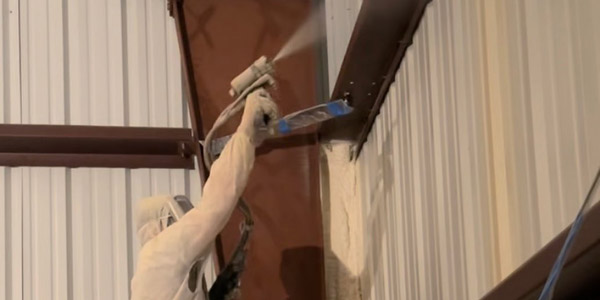
The main ingredient is methylene diphenyl diisocyanate, blended with fire retardants, polyol resins, surfactants, and catalysts. Thus, causing the material to expand and solidify when injected into cracks and gaps within the walls and ceilings.
As said earlier, spray foams offer genuine thermal insulation but feature some sound-blocking properties. When used between walls, cracks, and gaps, the hardened spray foam provides extra cushion to block out external airborne noise.
NOTE: spray foam delivers a better result when used with other effective soundproofing methods. It’s more like improving the performance of the already-in-place soundproofing models. Besides, it’s an infallible way of sealing cracks and crevices to prevent noise from migrating into your room.
Types of Soundproofing Spray Foam
There are two types of spray foam insulation: Open-cell and closed-cell insulation. Both options consist of components that mix upon application into walls or cavities. They expand to fill the cracks and gaps before hardening.
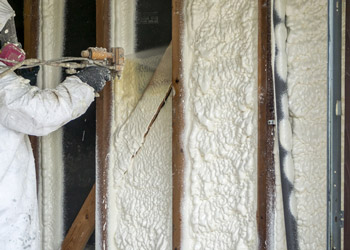
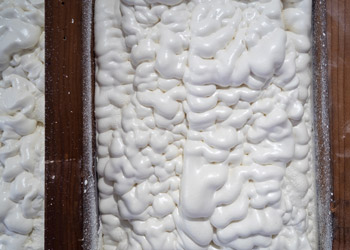
The open-cell spray foam is fragile, which explains its lower insulation value. But for its counterpart, closed-cell foam, it’s rugged and offers the closest thing to 100% seal. It has a higher R-value and is pricer than the open-cell alternative.
Open-Cell Spray Foam
If it’s not called an open-cell, it’s half-pound foam insulation. This type of spray foam is easy to identify with its sponge-like look and texture. It’s not very rigid and has tiny pores containing carbon dioxide.
This light spray foam can expand up to 3 inches, which makes it ideal for filling voids, crevices, and cracks. It offers an airtight seal to odd surfaces.
Open-cell spray foam is cheaper and offers a decent thickness. Thus, it’s most sought-after for general soundproofing. The high-performing ones are great for absorbing sound due to their porous nature.
Closed-Cell Spray Foam
This is a denser, heavier, and more rigid alternative to open-cell foam insulation. It contains polyurethane with no open cells. Unlike its counterpart with a sponge-like look, this foam insulation features a compact structure with no room for air and heat transfer.
Another outstanding hallmark of the closed-cell spray foam is its water-resistant property. It keeps condensation at bay.
But where it comes short is its expansivity. The open-cell options can seal up to 3-inch deep cracks and holes, not the closed-cell. Its expansion is limited to an inch. Therefore, it’s best used to reinforce seal cracks and wall construction because of its dense structure and short expansivity.
Soundproofing Spray Foam for Existing Walls Review
1. Loctite Tite Foam Gaps & Cracks White Insulating Foam Sealant
The Loctite Tite Foam is my top pick for sealing gaps and cracks. Thanks to its fantastic flexibility, high density, powerful adhesion, and protective UV resistance, it’s the best foam sealant. And you don’t have to take my word for it; there are more than 10,000 happy customers to convince you.
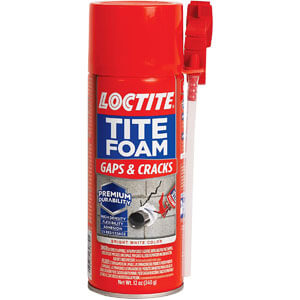
This manufacturer boosts its ability to seal up to 1-inch cracks and gaps airtight. Its application cuts across all boards, from existing walls to HVAC ductwork.
Let’s get down to its unique hallmarks;
This top-selling sealant offers flexible foam with incredible density to ensure a 100% reliable seal. Its airtight seal is handy for warding off moisture, noise, air, and especially pests in the crawlspace or basement. No more cockroach infestation and noise from your neighbor! Furthermore, I love its New-Gen polyurethane foam, which offers exceptional durability.
That’s one thing. This composition cures within 24 hours but comes tack-free in less than 8 minutes. However, you have to wait about an hour to cut.
Worth mentioning;
Loctite Tite Foam has one of the most robust adhesions allowing it to bond with a wide range of building materials, from stone to wood.
If the noise source is from gaps or cracks in your door frame, shared wall, ceiling, or windows, the Loctite Tite Foam is the best sealant for a noise-free room. Save yourself a massive bundle of money and still get the premium result with this sealant!
Pros:
- Expands quickly and cures on time
- Impressive noise deadening
- Affordable price point
- Best for sealing cracks and gaps
- Impressive 8-min tack-free performance
Cons:
- It can be messy even with the applicator
- The applicator’s nozzle is not a breeze to clean
2. Loctite Tite Foam Big Gaps White Insulating Foam Sealant
If the hole is big, you should buy the senior Loctite Tite Foam Big Gaps. It’s the best in class with its ability to fill up to 3-inch gaps. It’s more like the top-selling Tite Foam Gaps & Cracks but has a better expansion and is more expensive.
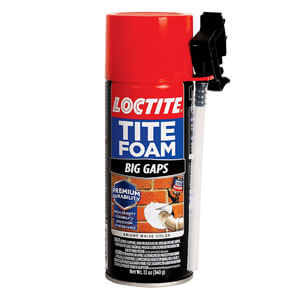
This unit offers the same superior airtight seal to block out moisture, air, and noise from outside. This foam sealant is super durable thanks to its uniform cell structure and huge density.
What’s more?
It’s the perfect spray foam to meet your remodeling insulation needs. This new-age polyurethane-based insulating foam sealant offers firm adhesion. You can use this single product to seal big gaps in building materials, from brick to wood.
Also, flexibility is another perk of this high-quality acoustic foam sealant. It offers a super flexible seal to handle the rigors of moving material or building.
No more bowing windows and doors or compromised seals!
Even better;
Loctite Tite Foam Big Gaps offers more than just thermal insulation; this sealant effectively dampens the raucous for a quiet and peaceful home.
Pros:
- Perfect for sealing large holes
- Insulate up to 3-inch cracks and gaps
- Dense and flexible for hard-line seal
- Speedy 8-min tack-free
- Affordable price point
Cons:
- The application can be messy and difficult to clean
- No hope of reusing the can once it’s open
3. GREAT STUFF PRO Gaps and Cracks – 24oz Fireblock Foam
The GREAT STUFF PRO Gaps and Cracks is the best soundproofing spray foam for large home improvement jobs.
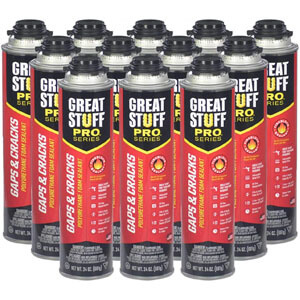
This product has a gun to easily apply the highly expansive foam to cracks and gaps with little or no mess.
Unlike the Loctite Tite Foam Big Gaps application, this gun is resealable. You can save the remaining foam sealant for future insulation needs, even after opening the can. ZERO wastage!
Plus, It can insulate gaps up to 3 -inches deep, thanks to its innovative gun system.
On top of that;
“Its adhesion performance is top-notch,” a customer review, and I concede. It bonds powerfully with wood, metal, glass, plastic, and masonry. Meaning once you are done soundproofing the walls, you can use the rest for plumbing and wiring penetration and HVAC systems.
Also, the foam comes in an orange color, which is quite different from the lush white foam of the Loctite Tite Foam Big Gaps. While it might require you to paint, the orange color is good for easy identification.
Want an airtight, water-resistant seal to seal many cracks and gaps during your DIY home remodeling? Save more on this insulation job with the GREAT STUFF PRO Gaps and Cracks.
Pros:
- Insulate 3-inch deep cracks and gaps
- Resealable gun to avoid wasting foam
- Water-resistant seal
- Suitable for soundproofing, electrical, and plumbing
Cons:
- Not truly fire resistant as advertised
4. Seal Spray Foam High-Performance Closed Cell Insulating Foam
The Seal Spray Foam is another decent option for insulating a deluge of cracks and gaps. But that’s not why this product is famous. It’s designed with DIYer in mind. It’s easy and foolproof to use.
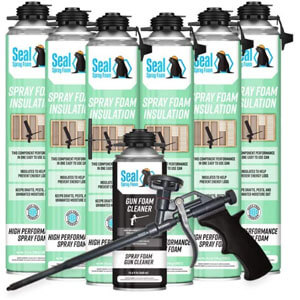
It comes with a 15-inch Spray Gun to apply the 28-ounce closed-cell foam sealant directly to the cracks and gaps in the wall. According to the manufacturer, a single can cover nearly a 25-ft board.
The sealant provides an airtight seal to improve your home’s soundproofing properties. It’s simple to assemble and has a massive coverage, which is 5x cheaper than hiring a pro for sound insulation installation.
Is that all?
The Seal Spray Foam features a compact design that eliminates the stress of hauling large tank disposal. A massive win if you need to insulate small spaces.
Also, two people can use this spray simultaneously, which halves the work time. Another thing it splits is the cleaning time. This product is super easy to clean, thanks to the included seal cleaner.
Pros:
- Suitable for 1-inch deep small and large insulation jobs
- Features a compact design
- Simple to use
- Perfect for sound and thermal insulation
- It comes with a seal cleaner
Cons:
- On the pricey side
5. GREAT STUFF Window and Door Insulating Foam Sealant
Whether you use a soundproof curtain or not, it won’t matter if there are gaps in your windows and doors. So, it’s best to purchase the GREAT STUFF Window and Door Insulating Foam Sealant for the best air-sealing solution.
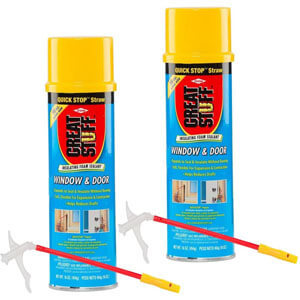
This foam sealant offers an inexpensive, effective way of instantly sealing air leaks. Its composition expands and cures quickly for a clean, water-resistant seal. It is flexible enough not to compromise its airtight seal.
Also, the seal does a great job of dampening the noise once the door or window is shut. Also, the foam can block out the draft and other air leaks.
Here’s more;
This product which comes in a pack of 2 16-ounce cans, features the NEW Quick Stop Straw Technology. This latest feature lets you apply the acoustic foam sealant with ZERO mess on any surface. So, NO more long cleaning hours afterward.
My only concern is the nozzle, which is fragile. It’s imperative that you handle it carefully. Otherwise, it breaks and halts your insulation project in track.
Pros:
- Easy to control
- Tack-free in less than 15 minutes
- Impressive responsiveness to weather changes
- Yellow-colored foam for easy identification
Cons:
- Quick expansion, so filling the gap to the brim causes overflow.
Related FAQs
Foam sealants mainly consist of polyurethane material, which can either come in closed-cell or open-cell structures. For the best noise absorption performance, opting for an open-cell foam sealant is best. Its counterpart is not so great at deading noise due to its rigid insulation foam.
If you don’t want to use a foam sealant, here are other effective options:
● Fiberglass insulation
● Rockwool Insulation
● Blown-in Cellulose
If there are gaps and crevices on your ceiling, you can use acoustic spray foam to seal the noise source. However, it’s essential to know that it won’t stop an impact noise like stomping noise.
Conclusion
Sealing the cracks and holes in your walls, doors, and windows is essential. It complements your overall soundproofing endeavors. Even better, it boosts your home’s noise-blocking performance.
However, not all spray foams are excellent soundproofing materials. If you are unfamiliar with these products, it’s easy to make the wrong choice.
Hence, I’ve revealed the top 5 best soundproofing spray foams for existing walls. They are easy to apply to save you thousands of dollars paying a professional.
